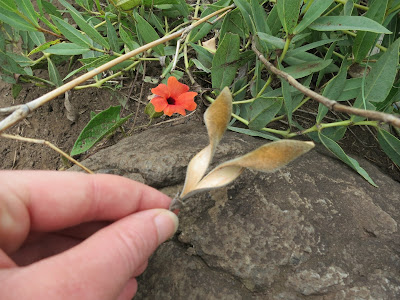When Sean and I asked about it, the children
and staff here informed us that there is a path leading to the top.
We resolved to climb it before we left, and the other morning we set
out to do just that. We filled our small day packs with water and
some light snacks, and put the word out that anyone who wanted to
join us was welcome to come along. Two of the girls here, Tuma and
Laudia, jumped at the opportunity to get some exercise, and the four
of us set off with them in the lead. Although we could have managed
okay without them, we were glad to have some “tour guides” along
who had hiked the mountain before and who knew the way.
We passed through the town, walked over
the train tracks, and crossed a large field before we really started
climbing. Once we did, we found the path to be quite steep much of
the way, and slippery with loose dirt and gravel at times. We
strolled passed farm after farm as we ascended the mountain—some
being tended by their dedicated owners, others occupied only by their
steadily growing crops.
 We also passed numerous people on the trail,
most of them carrying heavy loads either up or down the mountain.
Almost everyone we came across was curious. “Who were we?” “What
were we doing?” they would ask the girls in Swahili (always, of
course, after extending a customary greeting) to which they all
received the answer “We're climbing the mountain!” Most shot back
puzzled looks, and if I had to guess, probably responded with
something along the lines of “No really...” or “but WHY?”
They simply didn't understand the concept of climbing the mountain
just for fun, for exercise, or to see the view from the top. They
couldn't wrap their minds around why anyone would want to climb it
who didn't have a farm on it (which we obviously didn't).
We also passed numerous people on the trail,
most of them carrying heavy loads either up or down the mountain.
Almost everyone we came across was curious. “Who were we?” “What
were we doing?” they would ask the girls in Swahili (always, of
course, after extending a customary greeting) to which they all
received the answer “We're climbing the mountain!” Most shot back
puzzled looks, and if I had to guess, probably responded with
something along the lines of “No really...” or “but WHY?”
They simply didn't understand the concept of climbing the mountain
just for fun, for exercise, or to see the view from the top. They
couldn't wrap their minds around why anyone would want to climb it
who didn't have a farm on it (which we obviously didn't).
For these people, climbing the mountain
was the result of the unfortunate location of their farm. In
Tanzania, farming is a way of life—even if you do something else
for work, you also farm in
order to grow your family's food for the year. Virtually
all the land gets farmed, and if you're not quick enough when it
comes time to claim your space, you end up stuck with a crappy plot.
The less desirable land is that which is far from a water source, has
poor soil quality, or is at the top of a very steep mountain.
We continued passing the farms—each
with it's meticulously planted rows of crops—the entire time we
were hiking. Corn, peas, potatoes, beans, cabbage, more corn... all
the way up. The entire
time we continued passing people working on these farms. It took us
two hours to reach the top, and the whole time, I kept thinking “holy
cow! These people do this every day
to get to their farms... and
then they
work on their farms!
Sometimes for ten hours they work. And then they have to hike back
down carrying all their equipment...”
I
was as baffled by this as they were by our desire to hike the
mountain for fun. No wonder they couldn't make sense of it. In
Tanzania, the people mostly work. They work to eat, they eat, and
they sleep so they can work again tomorrow. They are no strangers to
exercise, but know it only as a bi-product of long hours and
back-breaking labor.
When
we reached one of the mountain's many crests and decided we had gone
far enough, we sat down and the four of us guzzled our water and shared a
snack. We admired the view over the rolling patchwork hills and the
backdrop of Uyole down below us.
If
the farmers seemed puzzled before, they were even more puzzled when
we passed by them again so soon heading in the opposite direction. To
them, making such a strenuous climb for such a short visit at the top
seemed ludicrous. We simply laughed and shrugged, and continued on
towards home...
 |
| An interesting looking seed pod (?) that I found along the way along with one of the many beautiful and perfectly symmetrical orange flowers we saw |






I am so grateful for the frequent posts! Yaay you guys.
ReplyDelete